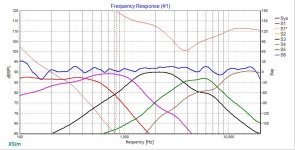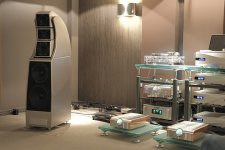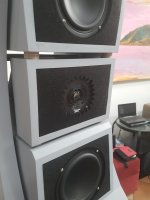There seems to be phase data missing in most of the files. There is software to calculate just that, like Response Modeler. It also simulates what baffle does to frequencies. Please attach that pdf where manufacturer graphs are to be found. When you model each driver response, you also model its position on the baffle, and you can also model internal enclosure volume which changes low end response.
I went to try and redo them. Jaycar's site is messed up, they just remodelled it and it thinks they have no speakers.
If you'd like to post the pdfs?
I think I still have them..just a sec...
There seems to be phase data missing in most of the files. There is software to calculate just that, like Response Modeler. It also simulates what baffle does to frequencies. Please attach that pdf where manufacturer graphs are to be found. When you model each driver response, you also model its position on the baffle, and you can also model internal enclosure volume which changes low end response.
Thanks Lojzek, I have posted the files, however form preceded function on this build, cost and availability also. The finished result is more than I expected, but there is always room for improvement, before cost and availability become an issue. Especially if I have made an error, for example, taking the build on in the first place..🙂🙂.
Regards S
Clearly, there is no error 😉SirDystic said:Im very happy with the outcome
Naturally, the sim is one of the keys to refining it further, and I'm looking at Jaycar's plots right now. These were never their strong suit.
When I look at the plot of a system's woofer I expect to see/extrapolate a level reference looking at the 100Hz region. Not in this case.
Attachments
Can I ask what was your criteria for choosing crossover points?
I'll get back with those files with phase information.
I'll get back with those files with phase information.
Thanks Allen, the crossover points were chosen around any one drivers capability and the predicted reasonable response curve, there were other drivers available at the time that might have been a better choice, however similar appearance and construction swayed me the direction I went, if only for aesthetic reasons.. for example the 12" is a back mount, that was a little inconvenient, but you wouldn't know it looking at it in situ..If you believe moving the crossover points would be beneficial, I'm all ears.. The design makes the crossovers easy to alter..
Much appreciated
S
Much appreciated
S
Sounds great. Here are the curves with phase. They seem to include some unwanted reflection information from testing, which might be best blocked out by sight if you can recognise it.
There was no tweeter impedance plot so I bundled the old one in the zip.
I have not simulated the baffles. Bit of a complex topic as well given their variety, the room and so forth. Expect a little variation in, just for example, each driver's chosen level with the current amount of data available.
There was no tweeter impedance plot so I bundled the old one in the zip.
I have not simulated the baffles. Bit of a complex topic as well given their variety, the room and so forth. Expect a little variation in, just for example, each driver's chosen level with the current amount of data available.
Attachments
Much appreciated Allen, Ill have a look.. And I'm sorry I would not recognize an unwanted reflection in a response curve if I fell over one..🙂..
Cheers S
FNQ
Cheers S
FNQ
Quick FWIW - the simulations aren't including baffle step compensation etc, so they won't be strictly accurate.
Best bet is measure the drivers in the cabinets.
Second best is use The Edge to simulate the diffraction effects.
Chris
Best bet is measure the drivers in the cabinets.
Second best is use The Edge to simulate the diffraction effects.
Chris
Quick FWIW - the simulations aren't including baffle step compensation etc, so they won't be strictly accurate.
Best bet is measure the drivers in the cabinets.
Second best is use The Edge to simulate the diffraction effects.
Chris
Thanks Chris, at this stage I have no way of measuring. Either way the bass cabinet has its own amplifier and crossover section, so there is room for a certain amount of compensation there, be it a sledge hammer to a tack approach.. I'm looking forward to being a little more scientific in terms of measurement..All I can do ATM is be certain I'm in the ball park..🙂
Cheers
S
Chris sure, and not least to get the lay of each baffle from different angles, and choosing where to cross.
What I like about this is it copies a known good design. As a result it should just be a matter of finding the wanted bands for each range etc.
Sir, I looked at the jaycar offerings. The 5 ways from woofer up have a sensitivity of 90, 89, 89, 88, 91.
Some of these cone drivers would prefer to be crossed lower than they are, to avoid narrowing directivity and cone breakup (although it might be worthwhile to learn Wilsons intentions in a number of things)
What I like about this is it copies a known good design. As a result it should just be a matter of finding the wanted bands for each range etc.
Sir, I looked at the jaycar offerings. The 5 ways from woofer up have a sensitivity of 90, 89, 89, 88, 91.
Some of these cone drivers would prefer to be crossed lower than they are, to avoid narrowing directivity and cone breakup (although it might be worthwhile to learn Wilsons intentions in a number of things)
Attachments
Yes Allen absolutely, although these may look similar to the Wilsons purely on aesthetic grounds, some of the principles used naturally are duplicated here. making use of them is another story. In the absence of any testing gear on my part, for the time being all I can do is get close. Where would you prefer to see the crossover points, there is nothing stopping me from making alterations in the meantime. After all I'm stuck at home just like many others at the moment...🙁
A question, Test mic, will a Umik do for me for my purposes, Ill have to buy offshore.. And Chris, reading through my own posts I may have come across as dismissive with relation to your comments, this was not my intent obviously, I have studied what you suggested..Attached is a picture of my attempts to mitigate reflections and baffle step issues with absolutely no science to back it up, Its wool felt, stands slightly proud of the edges.not my idea BTW..please note that the upper modules do not yet have radii, been fine sanded or prepped. MDF as many have noted here does weird stuff especially on the end grain over time, I live in the tropics with an ambient temp of between 20 and 40 C, and humidity that wets your socks when they are hanging on the washing line, so Its primer for at least a season or five until the biscuit board settles down.. 🙂
Attachments
Last edited:
OK Now as you are using Jaycar drivers I have to ask which series of drivers. Jaycar have been very inconsistent over the years but some of then have been excellent
Hey Moondog, I believe they are called the response range, Im sure I have the codes here if you want them. I think I pointed out earlier that the 12 was a rear mount, and really inconvenient to use . But they seemed to behave together, at least on paper.and in practice. To that end Ill be buying a full set of new ones to put into storage should I have a failure., because I'm sure as you say, parameters and quality, will change...
- Home
- Loudspeakers
- Multi-Way
- A 5 way DIY




